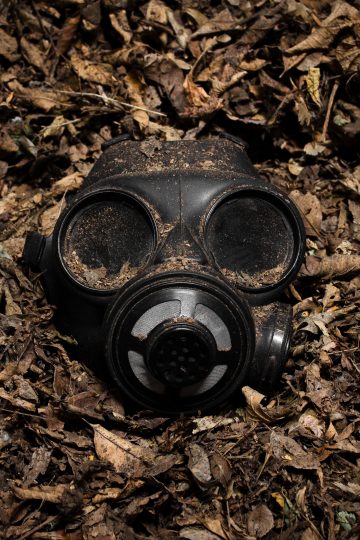What is toxic masculinity?
Masculinity
A sensible person's guide to toxic masculinity - what it means, whether it's valid, and if we can find any use in it...
“Toxic” was the Oxford Dictionary’s 2018 Word of the Year, an accolade for a word “judged to reflect the ethos, mood or preoccupations of the passing year, and have lasting potential as a term of cultural significance.”
One of the reasons for its sudden popularity is of course the use of the phrase ‘toxic masculinity’. The Oxford lot said, “after ‘chemical’, ‘masculinity’ is the most-used word in conjunction with toxic this year. With the #MeToo movement putting a cross-industry spotlight on toxic masculinity, and watershed political events like the Brett Kavanaugh Senate judiciary committee hearing sparking international debate, the term toxic masculinity has well and truly taken root in the public consciousness and got people talking in 2018.”
Indeed.
Except, if only anyone could actually agree on what toxic masculinity actually means. The phrase has been used as an adjective to describe all men, or simply as a reference to a certain type of man, or instead just a certain type of behaviour, which could mean violence or sexual assault, or it could mean a bit of manspreading on the bus, or even, according to a certain way of thinking, opening a door for a woman in an act of ‘benevolent sexism’.
With toxic masculinity being such a catch-all phrase, it often devalues any salient points it brings up, as it gets people’s backs up before you can get into any discussion. We’ve certainly been wrestling with it, without outright rejecting it, finding that by its very ubiquity in debate around men today there must be some useful purpose in engaging with it.
But here we’d like to try and break down its meanings in order to try and get a true handle on it.
- The origins of Toxic Masculinity
The phrase can be traced back to a guy called, brilliantly, Shepherd Bliss, who was one of the leaders of the Mythopoetic Men’s Movement activist which sprang up in the 80s, and aimed to remythologise men: essentially remove the limited archetypes like “warrior and king” and end biological determinism and hierarchical thinking. Bliss wrote about a return to preindustrial cooperative masculinity, all raising barns and making fires, rather than competitive technological masculinity. He’s American with a white beard and looks a bit like a wise man the crew of the Enterprise would meet on a hippy planet in 60s Star Trek – yes, he’s a bit of hero. Originally he came up with the phrase to identify behaviours that were toxic to masculinity, bad for men in other words:
- Shame, disassociation and avoidance of emotional expression.
- Extreme self-reliance.
- Extreme aspiration for physical, sexual and intellectual dominance.
- Devaluation of women’s opinions, body and sense of self.
- Condemning anything feminine within another man.
Which, to our mind, looks pretty damn solid, and fair and reasonable, in the context of suicide being the biggest killer of men under 45 in the UK, and the emerge of organisations like CALM and Andy’s Man Club whose sole purpose is to get men together and allow them to open up about how they feel – life-saving, real-world stuff, aimed directly at dismantling the above behaviours.
In it’s original meaning, it shows toxic masculinity as a way to gather and identify cultural and social traits which are the enemy of men, not just women.
2. Toxic Masculinity vs Hegemonic Masculinity
Alright, let’s get heavy into this now. Toxic masculinity has also been seen as another name for hegemonic masculinity, or, perhaps more helpfully, as one of the more extreme aspects of it.
Hegemonic masculinity is a concept developed by Australian sociologist R.W. Connell which is defined as a practice that “legitimises men’s dominant position in society and justifies the subordination of women and other marginalised ways of being a man.”
Basically it’s about the culturally idealised form of manhood that is related to bread-winning and hitting the top of the social hierarchy. As described by psychiatry academic Terry Kupers:
“Hegemonic masculinity is the stereotypic notion of masculinity that shapes the socialisation and aspirations of young males…[it] includes a high degree of ruthless competition, an inability to express emotions other than anger, an unwillingness to admit weakness or dependency, devaluation of women and all feminine attributes in men, homophobia, and so forth.”
We may all recognise that in some of the older ways in which we have come to think of what being a “real man” is all about, primarily in the white, hetero, world. Perhaps the actual men we know personally – yes even the white heteros – are far more complex and emotional than this, but in the outside world, particularly at work, the above expectations still hold true. You are supposed to ‘perform’ in this way, and such social teachings remain commonplace for young boys. The problem being that the “real man” archetype is one which nobody could ever live up to, and leads to boys growing up believing they shouldn’t be weak, shouldn’t be vulnerable, shouldn’t be “a girl” and seek health advice from doctors, never mind mental health help. Men who adhere to this need for dominance and social control are more likely to suffer stress, depression, and addiction. And with the taboo of the feminine, and its associated reduction of women and gay men to subordinate positions, the teaching extends its damaging reach.
The counter argument to hegemonic masculinity is that it fails to deal with the complexity of social dynamics and competing forms of masculinity, even at the top level of rich old white guys, who may not always exhibit a John Wayne swagger, and ignores things like upbringing, and location. And then there’s the more positive values of hegemonic masculinity, which can include protection, strength, and team cooperation. Like when John Wayne helps a baby cow out of a river.
However, by identifying toxic masculinity as an aspect of hegemonic masculinity at its worst, socialised behaviour which cuts across all classes and backgrounds, you can separate out the areas which need some work. Of course, with hegemonic masculinity being so hammered into men from childhood, any attack on even the worst aspects can be taken as an attack on men as a whole, causing a lashing out, not least in the murky realms of the online ‘manosphere’ with its trolls and incels. It is hard for men to understand how we are shackled to certain notions of Being a Man, and it can provoke a cornered animal response.
But when you’re required to have dominance and control in a world that can’t be dominated and controlled, and you will forever be fruitlessly chasing that, then we’re trapped in false notions – it’s bondage, it’s hell. We can’t ignore this, we surely need to explore new rites of passage for boys with different values, and one way of approaching this is to identify toxic masculinity as the damaging aspects which we need to fight against; this is where we feel the phrase has a use.
3. Toxic masculinity is not masculinity
Certainly toxic masculinity has been used by some extremist groups as a description of masculinity altogether, which has resulted in an understandable counter argument to get rid of the phrase altogether, as has been stated in an article on this very site by Professor Eric Anderson who called its usage “neither sociologically sound, nor moral, to castigate the whole by one aspect of one’s actions.”
This is not something to dismiss and indeed anything which demonises men per se, is as reprehensible as a demonisation of, say, muslims.
There has also been huge resistance to the phrase from evolutionary psychologists. Gad Saad, ph.d writing in Psychology Today:
“There has been a relentless ideological attack on masculinity, stemming from radical feminism, the most recent example of which is the bogus term “toxic masculinity.” It literally seeks to pathologise masculinity in ways that are profoundly harmful to the existential sense of self of young men…most of the traits and behaviours that are likely found under the rubric of “toxic masculinity” are precisely those that most women find attractive in an ideal mate!”
Are we indeed simply performing sexual selection in following these ideals of masculinity? And women just bloody love it anyway? Hmm, our feeling is that there are major issues relating to masculinity which are subjugating women and damaging men – in fact, this is undeniable. Therefore, surely we have to question our drives, and not shrug our shoulders as such. The difficulty comes in the separation of evolutionary impulses and learned behaviours, or rather, in using our ever evolving minds to assess what behaviours work and what don’t in modern society, according to our ethical values.
This, then, is not about pathologising masculinity, rather at looking at certain extreme forms of masculine behaviour which we need to question.
4. Toxic masculinity as The Man Box
Here’s New York writer and first trans man to fight in Madison Square Gardens, Thomas Page McBee on how toxic masculinity relates to the schooling of kids in the Man Box:
“Just to define what sociologists call toxic masculinity: that’s not masculinity broadly, that’s not an adjective for masculinity, it’s a socialised set of behaviours that we teach boys in our cultures about what it means to be a man. That’s best illustrated by the idea of the Man Box. Which if you ask boys what ‘a man’ means they can tell you: men are strong, men don’t cry…and they put all these descriptions in this box, on purpose, because it’s very constricting. And then if you ask those same boys to think about a man in your life that you love, your dad or your coach, ‘how does he behave that doesn’t fit into this box?’ they always have a whole list of other behaviours that are considered ‘feminine’. So they can see what I’m supposed to do and what I actually appreciate. It’s very different.”
5. A useful aside: Precarious Manhood Theory
Social psychologist Joseph Vandello, who with colleague at University of South Florida, Jennfger Bosson, in 2008 put together the Precarious Manhood Theory. It put forward the idea that young boys have to earn their manhood and grown men have to protect their manhood. When their manhood is threatened to be taken away once earned, they lash out. They posited that men are more anxious about gender than women, and its socialised: men police other men in how they’re supposed to be men, often through physical strength and sport as kids. This is because men are in a more valued position in society, and the emphasis is on not losing their position. Hence the lashing out. But it doesn’t mean men are supposed to be lashing out and fearful, its performative not biological.
As a great piece in Fatherly, puts it, this kind of precariousness is why any issues around masculinity provoke such hostile responses and why it is so difficult to effect change with men. Nevertheless is it necessary to try, and is one of the reasons why it is useful to engage with the phrase ‘toxic masculinity’ is because of its very provocative nature – how else do you get people to consider their actions and question their own behaviour unless it’s through provocation? Nothing is achieved through benign chat on the margins.
Therefore, we shall continue to use toxic masculinity as a term, as a way to define what we stand for and what we are against. We want men to discover more ways to be a man and not feel shamed for doing so.
So fuck toxic masculinity, let’s find truer masculinities, an overall New Masculinity, which we can all find some freedom in.
Do you agree?

Join The Book of Man
Sign up to our daily emails for the latest in the battle against toxic masculinity...

Join The Book of Man
Sign up to our daily newsletters to join the frontline of the revolution in masculinity.






















